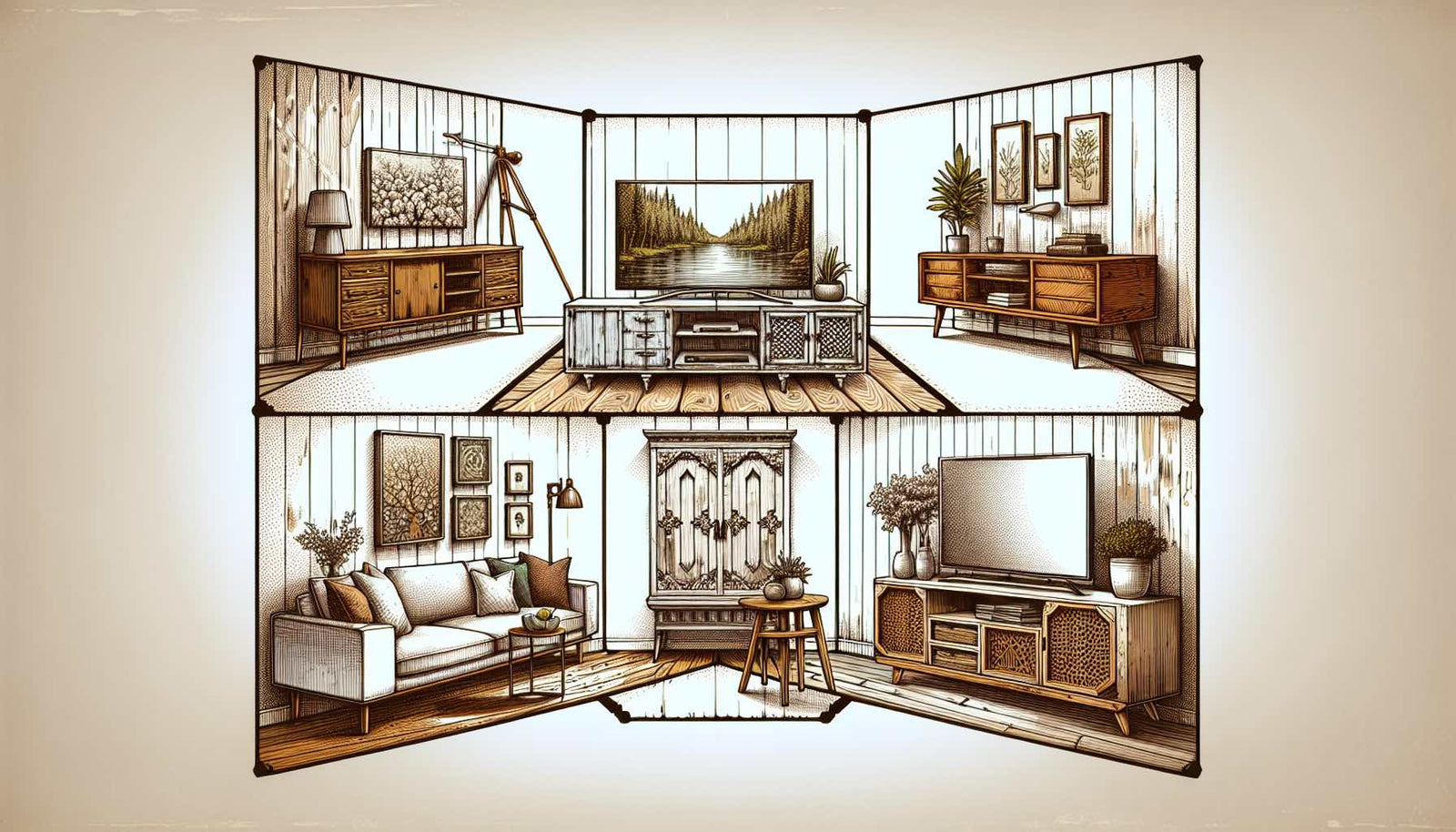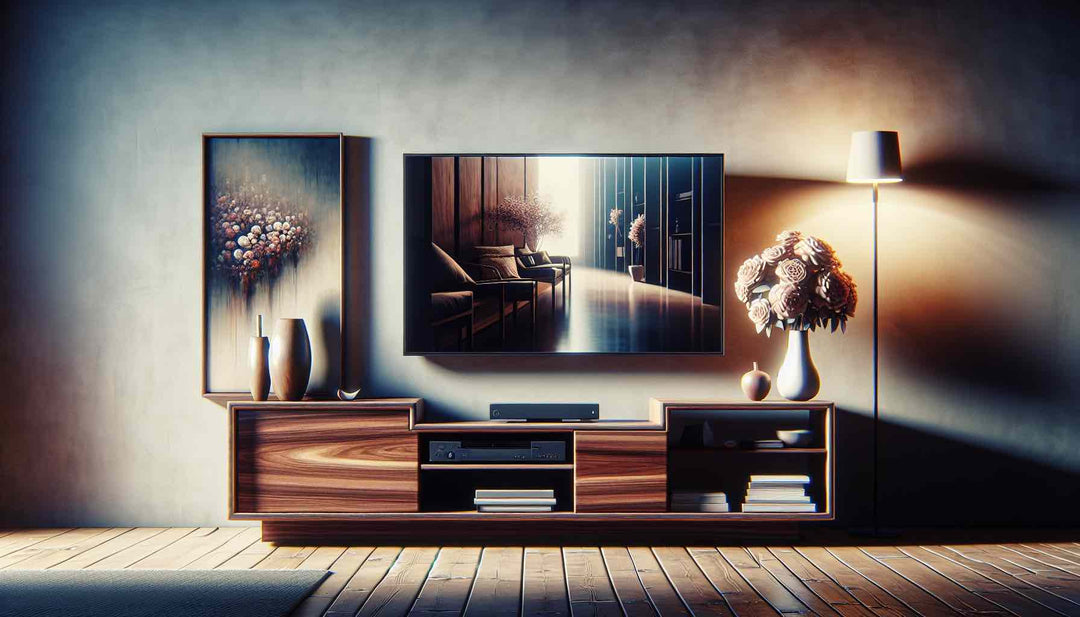How to Choose the Right TV Stand: Top Tips for Your Space

Choosing the right TV stand can be tricky. In this guide on how to choose the right tv stand, we will walk you through measuring your TV, understanding your room layout, and picking the right style and storage options. TV stands come in various types, including options like a bedroom TV stand for a cozy setup. Let’s get started on finding the perfect stand for your needs.
Key Takeaways
You must understand the exact size of your TV. This includes the frame and support parts. It is crucial for picking a TV stand that fits well and holds the TV securely.
The TV stand's width and height should be balanced for stability and comfort. The stand should be a few inches wider than the TV. The center of the screen should align with your eye level when seated.
Consider the style, material, and storage needs of the TV stand. Also, think about where in the room you'll put it. You want to be sure it complements your decor, supports your devices, and improves your viewing.
Choose the right TV stand for different rooms. For example, a bedroom TV stand makes a cozy setup for movie nights or watching sports. This is especially true when placed by a corner fireplace.
Understand Your TV Size

Before diving into TV stands, it’s important to understand the true size of your flat screen tvs. Most people know the diagonal size of their TV screen. But, this only tells part of the story. The TV screen size is often advertised as the diagonal measurement. It doesn't include the frame around the screen, which can add extra inches to the size. For instance, a 55-inch flatscreen TV has a screen width of about 48 inches. Its height is around 27 inches. Knowing the dimensions of your TV is essential for selecting the right tv stand sizes for your needs.
To ensure you get the right TV stand size, you need to measure the actual width and height of your TV. Use a measuring tape to measure from the left edge to the right edge of the frame. Don't forget to account for the height of the legs or the base. These are often not included in the advertised screen size. These exact measurements will help you find a stand. It will support your TV securely and beautifully.
Also, remember that the advertised size doesn't show how much space the TV will take in your room. Knowing the exact dimensions is essential. This includes the width, height, and depth. It is key for choosing the correct size TV stand. This step ensures the TV stand matches perfectly with the size of your TV and fits well in your intended space.
Determine the Ideal TV Stand Width
Once you have the exact dimensions of your TV, the next step is to determine the ideal width for your TV stand. A well-designed TV stand not only supports your TV but also contributes to the overall aesthetic of your room. The general rule of thumb is to choose a TV stand that is a few inches wider than your TV on each side. Typically, the ideal TV stand should be about 3 inches wider than the TV on each side. This ensures both balance and safety. An oversized stand disrupts the room's harmony. An undersized one can be unstable and cause tip-overs (read our TV stand safety tips to prevent tip-overs).
The width of the TV stand also depends on the type of TV stand you choose. For example, a corner TV stand helps maximize space in a tight space because it is usually narrower. An entertainment center can be wider and more expansive. It must be wider than your TV. That is key for any type of stand and for getting the right size stand for your space.
Besides aesthetics, the right tv stand size is crucial for stability. A low tv stand that is too narrow can tip over easily, especially if you have children or pets running around. On the other hand, a stand that is too wide may look disproportionate and overwhelming in a smaller room. Choosing the right size TV stand is key. It makes it safer and looks better.
Calculate the Optimal Height for Your TV Stand
The height of your TV stand is key. It ensures a comfortable view. To avoid neck strain and eye fatigue, it’s essential to calculate the optimal height for your TV stand. Start by measuring the average eye level when seated. It's usually about 44 inches (111.8 cm) from the floor. This measurement can vary slightly depending on the height of your seating arrangement.
Once you have the average eye level, the next step is to find the middle of your TV screen. Divide the height of the television in half to get this measurement. Subtract the TV's middle height from the eye level. This gives the best TV stand height. For instance, if your eye level is 44 inches and your TV’s height is 24 inches, the middle of the TV would be 12 inches. Subtracting this from your eye level means the top of the TV stand should be around 32 inches high.
Follow these steps. They ensure that your TV screen's center is at or just below your eye level. This is the ideal height for viewing. This placement prevents neck strain. It makes viewing more enjoyable. It’s also important to ensure the height is within an inch or two of the stand's height. This is best for good results.
Consider the Viewing Distance
Another crucial factor in setting up your TV stand is the viewing distance. The general rule for placing a TV is to position it at a distance that is about twice the size of the screen. This is based on the screen's diagonal size. This can help optimize viewing experience and minimize eye strain. For example, if you have a 55-inch TV, the ideal viewing distance would be around 8 feet or about 2.35 meters. This ensures you can view comfortably. It avoids straining your eyes.
High-res TVs, like 4K and 8K models, let you sit closer. You won't lose picture quality. This flexibility can be particularly useful in smaller rooms where space is limited. However, for larger TVs with lower resolutions, sitting too close can result in a pixelated image. Therefore, it's important to find a balance. It should suit both the size and resolution of your TV. This will optimize your viewing.
Match the TV Stand Style to Your Room

When choosing a TV stand, it’s essential to match its style with the overall aesthetic of your room. TV stands come in various styles. These include rustic, traditional, and modern. Also farmhouse, mid-century, and vintage. Each style offers unique elements that can enhance the look of your space. For instance, mid-century modern TV stands often have sleek shapes. They have four tapered legs and dual-slatted sliding doors for a touch of accent. These stands have extra storage. It is revealed by sliding doors. They also have open middle shelves for remotes or games.
If you like contemporary minimalism, choose TV stands with clean lines. They should have neutral colors. These colors include white, grey, and light brown. These colors make your room look more capacious and vibrant. But, dark solid colors can be used for a TV stand in light rooms. They make it the center of attention.
For a cozy setup, especially in a bedroom, a bedroom TV stand can be a great choice. It can make a perfect spot for movie nights or watching sports. This is especially true when placed by a corner fireplace.
For those who like modern and retro elements, mix unique shapes, geometric art, and warm wood. This mix can create a mid-century modern look. JALG wooden TV stands can blend with any room. It keeps a clean look and offers practical storage.
Evaluate Storage Needs

Storage is a crucial aspect to consider when selecting a TV stand. Think about the number of devices and accessories you need to store. These include gaming consoles, streaming devices, and sound systems. Open shelving allows easy access. It also provides visibility to items like media players and decor pieces. This style is perfect for those who prefer to keep their gadgets on display and within reach.
Closed cabinets are effective for hiding clutter. They also keep electronic devices dust-free. They give a cleaner look. They are especially useful if you have many small accessories. These include remote controls, DVDs, and cables. Drawer dressers and TV stands offer hidden storage. They hold these items, helping to keep a tidy and neat look.
For those with extensive storage needs, entertainment centers are the largest option. They need a big room. But, they have many shelves, drawers, and compartments. You can use them to store all your electronics, media accessories, and media consoles. This TV stand is for media enthusiasts. They need lots of storage and prefer a central entertainment hub.
Choose the Right Material

Selecting the right material for your TV stand is key to ensuring durability and style. Common materials used in manufacturing include:
- Metal
- Wood
- Glass
- Medium-density fiberboard (MDF)
Wooden TV stands are made from Teak, Acacia, Indian Rosewood, Mango wood, and reclaimed wood. They offer a classic and sturdy option. Bamboo is another sustainable choice. This is because it grows rapidly and is very strong. Premium brands often use Oak, Birch or Walnut.

For a modern look, consider reinforced glass. It can be tempered or laminated. It's both durable and stylish. Glass TV stands can support substantial weight while adding a touch of elegance to your room. Metal stands are often made from steel or aluminum. They provide a minimalist and industrial look. They combine strength with a sleek appearance.
Another option for a modern look is choosing acrylic tv stand. It is lightweight, transparent, and shatter-resistant.

Concrete TV stands are another durable option that offers an industrial aesthetic. They are exceptionally sturdy and can become a bold statement piece in your living room. Also, recycled plastics are gaining popularity. They are durable and help a circular economy. Each material has its own benefits. So, choose one that fits your style and durability needs.
Optimize Placement in Your Room
Proper placement of your TV stand can greatly enhance your viewing experience. Here are some tips to consider:
- Ensure that the TV is positioned at an angle where sunlight or indoor lighting won’t cause a glare.
- Avoid placing the TV in front of a window to prevent reflections and glare.
- Position your TV across from your sofa to make it a focal point and enhance the viewing experience.
In a bedroom, placing a TV stand by a corner fireplace can create a cozy setup. It's great for movie nights or watching sports.
Center the middle of your TV with the middle of the largest seating area in your room for a balanced look. This not only improves aesthetics but also ensures everyone in the room has a clear view of the screen. Also, don't put the TV above a fireplace. It may be too high and lead to bad viewing angles.
Put the TV away from busy areas. This reduces disruptions and ensures a comfy view. Also, keep it away from heating and cooling vents. This will avoid damage and keep a comfortable temperature for viewers. Follow these tips. They will help you place your TV stand well. This will create a more enjoyable viewing environment.
Explore Different Types of TV Stands
Exploring different types of TV stands can help you find the perfect fit for your space. Some options to consider are:
- Media chests
- Corner TV stands
- Floating TV stands
- Entertainment centers
- Bedroom TV stands
Each of these options offers distinct benefits. For example, floating TV stands save space. They mount the TV to the wall and often include built-in cable management. This helps organize and hide wires well.
Corner TV stands are designed to nest nicely in a corner, making them ideal for small rooms. They fit neatly into the space while also providing minimal storage. Entertainment centers have many designs. For example, there are pier style units with tall cabinets for storage and display. There are also hutch entertainment centers. They have shelves and cabinets around a central TV space. These can be as tall as the ceiling. Fireplace entertainment centers combine a TV stand with an electric fireplace. They provide warmth and a nice focal point. Also, TV consoles are a stylish and useful way to organize your entertainment devices.
TV armoires have a cabinet with doors that hide the TV when not in use. They often have drawers for extra storage. This makes them one of the tallest media center options. Bedroom TV stands can create a cozy and useful setup. This is especially true when placed by a corner fireplace. They're perfect for movie nights or watching sports. Each type of TV stand has unique features. They can enhance your living space. So, consider your room layout and storage needs when making your choice.
Decorating Tips for Your TV Stand

Decorating your TV stand can add a personal touch and make your living space more inviting. Here are some tips to consider:
- Add movement to your TV stand. Do this by adding decor items that vary in height, material, color, and shape.
- Place a tall vase next to a stack of books or a small sculpture to create visual interest.
- Coordinate your TV stand decor with the hardware color of the stand to create a cohesive look.
Limit the number of decorative objects on the TV stand to three or four to avoid a cluttered appearance. Use faux plants to add color, life, and style, and choose vases that complement your room’s aesthetic. By following these decorating tips, you can enhance the look of your TV stand while maintaining a clean and organized appearance.
Summary
Selecting the right TV stand involves more than just finding a place to set your television. You need to consider your TV’s size, the stand’s width and height, your viewing distance, and your room's style. Sometimes you also might need to measure your space for TV stand. By understanding these factors, you can choose a TV stand. It should fit your TV perfectly and enhance your living space's look and function.
Remember to assess your storage needs. Choose the right material and place your TV stand well. This will ensure a comfy and fun TV experience. It could be for the living room or a bedroom. Choosing the right TV stand can enhance your viewing. Keep these tips in mind. They can help you turn your living room into a stylish and useful entertainment hub. Happy TV stand shopping!
Frequently Asked Questions
How do I measure my TV to find the correct size TV stand?
Measure the real width and height of your TV, not just the diagonal screen size. Use a measuring tape from the left to the right edge of the frame and from the base to the top edge of the bezel. This will find the right size TV stand.
What is the ideal width for a TV stand?
The best TV stand should be 3 inches wider than the TV on each side. This extra width ensures that it looks good and is safe.
How do I calculate the optimal height for my TV stand?
To find the best TV stand height, measure from the floor to viewers' average eye level. Then, subtract half your TV's height. This will give you the optimal stand height.
What is the recommended viewing distance for my TV?
For the best viewing experience, place your TV at a distance about twice the screen's diagonal size. This distance can be adjusted if you have a high-resolution TV.
What should I consider when choosing the material for my TV stand?
When choosing your TV stand's material, consider the style and durability needs. Also, weigh the benefits and look of wood, metal, glass, acrylic, and medium-density fiberboard.
















